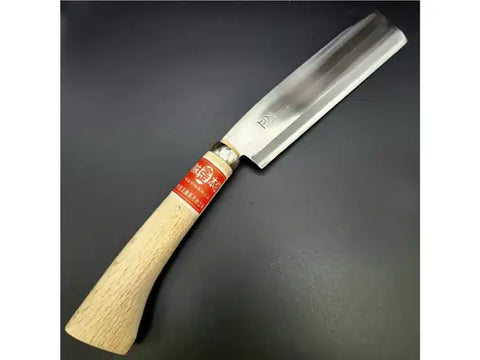
Aogami (Blue Steel)
Aogami, or Blue Steel, is one of the most prized carbon steel alloys used in Japanese knife making. It is produced by adding tungsten and chromium to Shirogami (White Steel), giving it greater wear resistance and improved edge retention. It is popular in high-end knives for its hardness and exceptional cutting ability.
What is Aogami steel and why is it so valued in Japanese knives?
When we talk about high-end Japanese knives , one of the terms that comes up most often is Aogami , also known as Blue Steel . But what makes it so special? And why do Japan's most reputable blacksmiths use it for their most demanding blades?
In this article, we explain everything in clear terms and with real-life examples of knives available in our store.
What does Aogami mean?
Aogami (青紙) , literally meaning “blue paper,” is a high-carbon Japanese steel manufactured by Hitachi Metals . Its name comes from the color of the paper the steel was originally wrapped in during shipping, not the actual color of the metal.
There are three main types of Aogami:
-
Aogami #1 : Higher carbon content → sharper, more delicate.
-
Aogami #2 : Balance between sharpness, hardness and ease of sharpening.
-
Aogami Super : An advanced version with molybdenum and vanadium that improves edge retention and wear resistance.
They all include small amounts of chromium and tungsten, which makes them more wear resistant than white steels ( Shirogami ), without losing the ability to sharpen like a surgical blade.
Why is it so valued?
Aogami steel is a favorite among artisans, chefs, and collectors for several reasons:
-
Extreme sharpness : thanks to its purity and hardness, it can reach extreme sharpness without breaking.
-
Easy to maintain : Although it is a carbon steel and requires care, it responds very well to sharpening even after demanding use.
-
Aesthetics and tradition : Many Aogami knives feature kurouchi (darkened), migaki (polished) or tsuchime (hammered) finishes, giving them a unique character.
Furthermore, its use is linked to historical blacksmithing and traditional forging methods that keep Japanese knife-making culture alive.
How to care for an Aogami knife?
Being a high-carbon steel, Aogami is not stainless. This means that:
-
You should clean and dry the knife immediately after use.
-
It is ideal to lightly oil the leaf from time to time (camellia oil, for example).
-
Never put it in the dishwasher .
With use, the blade will develop a protective patina : a grayish or bluish film that beautifies the blade and helps prevent rust.
Some knives with Aogami steel that you can find in our store
Here are some examples of Aogami forged Japanese knives that you can buy today:
🔪 Nakiri Knife 16.5 cm Kanetsune Steel Aogami
The Kanetsune KC-920 Nakiri It is a Japanese knife specifically designed for precision vegetable cutting. Its 165 mm blade is forged with an Aogami No. 2 steel core.
🔪 Santoku Knife 17 cm Aogami Super Zenpou
Small, sharp as hell, and perfect for precision kitchen tasks.
🔪 Santoku Knife 18 cm Aogami Super Zenpou
The 18cm Santoku Knife Zenpou is forged from Aogami Super steel , known for its hardness and edge retention.
👉 Discover our entire knife collection here .
Conclusion
Aogami steel isn't just an alloy: it's a statement. Choosing a knife forged with this material means choosing precision, tradition, and beauty.
At Ryo Miura Japan, we handpick each model that uses this legendary steel, ensuring that each piece meets the quality standards you deserve.









